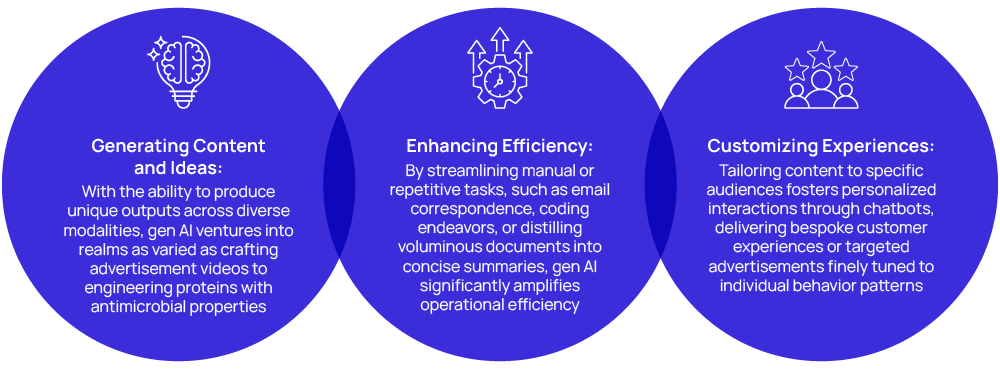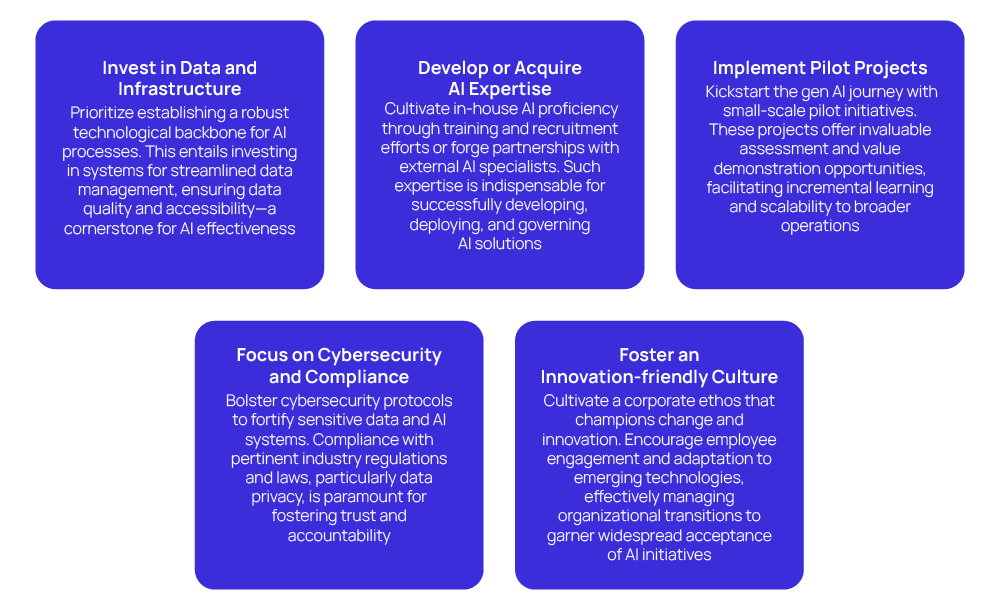This website uses cookies. By continuing to browse the site, you are agreeing to our use of cookies
Breaking Ground while Facing Challenges in Gen AI Adoption
Generative AI
February 15, 2024
Introduction
In today’s rapidly evolving technological landscape, businesses actively pursue innovative strategies to maintain their competitive edge. Against this backdrop, generative AI (gen AI) offers a compelling solution, empowering organizations to automate creative processes traditionally reliant on human intervention. This not only boosts productivity and efficiency but also drives cost savings.
Gen AI comprises a suite of algorithms capable of generating realistic text, images, or audio based on the patterns gleaned from training data. To achieve optimal outcomes, these foundational models require extensive training on vast amounts of unlabeled data, leveraging unsupervised learning techniques to discern patterns across diverse tasks.
For instance, GPT-3.5, a leading text generation model, can be harnessed for tasks such as responding to queries, summarizing text, or analyzing sentiment. Another notable model, DALL-E, excels in generating images and offering creative variations of existing artwork, showcasing the versatility of generative AI across multiple modalities.
Gen AI Capabilities
Gen AI models represent a transformative force in accelerating AI adoption, opening doors for organizations regardless of their depth in AI or data science expertise. These models unleash their potential across three key areas:

Challenges in Gen AI Adoption
With AI models capable of leveraging extensive online datasets, the need for responsible AI practices has become paramount to mitigate risks associated with copyrighted materials.
While embracing gen AI offers a competitive edge, it also introduces inherent challenges. Despite its significant potential benefits, implementing gen AI in process industries is hindered by several factors. These challenges are intricate, interconnected, and vary across industries. Key hurdles to gen AI adoption include:
Data Challenges in Gen AI Implementation
- Concerns Over Data Privacy, Security, and Complexity: In tightly regulated sectors, gen AI raises apprehensions regarding data security. The intricate nature of unstructured text and multimodal data necessitates inventive anonymization methods. The rapid evolution of gen AI complicates model selection, while incomplete datasets undermine reliability. Customers wrestle with security protocols amidst potential vulnerabilities.
- Customization Challenges and Skepticism: Industries aspire to deploy highly tailored gen AI solutions but encounter impractical hurdles, especially in endeavors involving extensive language model constructions. Skepticism surrounding gen AI underscores the necessity for a bespoke approach, meticulously tailored to individual customer specifications, encompassing system architecture, data assets, and business framework.
- Hallucinations and Legal Implications: Hallucinations within gen AI outputs present legal liabilities for companies. Concerns revolve around potential legal repercussions and reputational harm stemming from unintended distortions, underscoring the critical need to mitigate hallucination issues.
Project-Related Concerns in Gen AI Adoption
- Low Enterprise-Wide Adoption: Customers cautiously approach large-scale gen AI initiatives due to uncertainties surrounding technology reliability, potential impacts on existing systems, and apprehensions about the unknown. The unfamiliarity with the technology prompts a cautious investment approach to ensure desired outcomes.
- Viability & Sustainability Challenges: Despite recognizing the benefits of gen AI for routine tasks, users hesitate to embrace its transformative potential fully. Concerns regarding integration, scalability, and a limited understanding of gen AI’s broader implications impede widespread adoption.
- Long-term Architectural Perspective: Businesses encounter challenges in identifying or developing frameworks to integrate gen AI into existing stacks and systems seamlessly. The absence of defined norms and benchmarks contributes to hesitancy in widespread adoption.
- Pricing Model Concerns: The evolving pricing models of hyperscalers and niche providers, initially high-priced, deter some Fortune 100 companies. In response, companies adapt their pricing structures, exercising caution in custom/in-house build initiatives to avoid entanglement.
People and Team-Related Challenges in Gen AI Implementation
- Data Teams Guiding Gen AI Strategy: Prioritizing data teams over business teams in gen AI decision-making inadvertently fosters analysis paralysis. Data teams grapple with myriad data security considerations, resulting in decision delays and hindrances to progress, particularly in fast-paced, productivity-driven use cases.
- Team Composition and Business Models: Customers are reevaluating traditional engagement and business models in light of gen AI adoption. Exploring usage-based, token-based, output-based, and outcome-based models allows for reassessing candidate profiles and skill sets, leveraging existing predictive and analytical AI capabilities.
- Adapting to Paradigm Tech Advancements: Organizations encounter challenges in adapting to paradigmatic technological advancements like gen AI. These hurdles encompass the necessity to reconfigure current workflows, potential disruptions to refined processes, and the enterprise’s readiness to integrate gen AI into existing systems.
Looking Ahead
Looking ahead, organizations poised to excel with gen AI can concentrate on five pivotal strategies:

Conclusion: The Future of Gen AI Adoption
The integration of generative AI marks a notable stride for organizations striving to innovate and stay competitive amidst the swiftly evolving technological panorama. While the promises of improved productivity and tailored experiences are enticing, formidable hurdles like data privacy issues and intricate customization processes demand attention. Organizations can effectively confront these challenges through strategic investments in infrastructure, cultivation of AI proficiency, and nurturing an environment conducive to innovation. By doing so, they unlock generative AI’s boundless potential, propelling transformative shifts and igniting future growth.
About the Author

Arun Narayanan
With over 25 years of experience in Consulting, Pre-Sales, and Thought Leadership, Arun Narayanan leads the High Tech & Professional Services (HTPS) practice at Hexaware Technologies and is a key member of the Gen AI Consulting & Practice (North America) team. As an accomplished HTPS and Gen AI leader, Arun excels in driving meaningful business outcomes through technology. His expertise in customer management, combined with a strong focus on Strategy and Domain-specific solutions, enables him to deliver comprehensive services that effectively meet customer needs.
Read more
About the Author

Neha Jain
Neha is a seasoned content manager with 8+ years of experience, currently leading content initiatives for High Tech and Professional Services (HTPS) at Hexaware. She has experience managing content across diverse industries and is adept in crafting versatile content that supports thought leadership goals within the vertical.
Read more
Related Blogs

What Is Generative AI Consulting?
- Generative AI
- Digital & Software Solutions

AI in Global Capability Centers: Navigating People Challenges in Adoption
- Global Capability Centers
- Generative AI

Generative AI in Claims Processing: The AI Station for the Claims Ecosystem
- Insurance
- Generative AI

AI-Powered Dynamic Pricing: The New Retail Reality that Enhances Precision and Profitability
- Retail & CPG
- Generative AI

Agentic AI in Insurance: Transforming the Industry with Enterprise AI
- Insurance
- Generative AI

How Agentic AI is Transforming Pharma Sales: Hexaware’s Agentic AI Solutions
- Life Sciences & Healthcare
- Generative AI

Generative AI in Insurance: Transforming Challenges into Opportunities
- Insurance
- Generative AI

Ready to Pursue Opportunity?
Every outcome starts with a conversation










